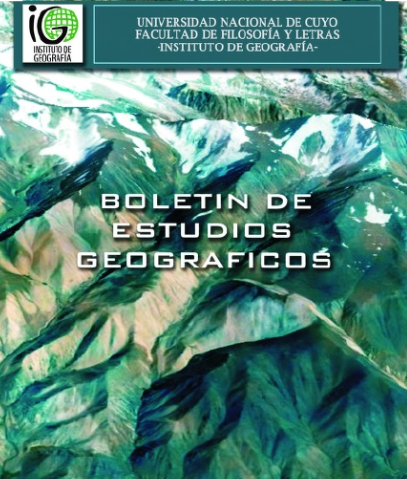Análisis comparativo preliminar de la variabilidad temporal del índice de vegetación en las áreas metropolitanas forestadas. Casos de estudio: La Plata, Mendoza, Santiago de Chile y Turín
Palabras clave:
morfología urbana, índice de vegetación, desarrollo sostenibleResumen
El trabajo estudia la variabilidad del índice de vegetación de diferencia normalizada (NDVI) en cuatro áreas metropolitanas, a partir de imágenes satelitales para los períodos estivales 1986-2011. Metodológicamente se realizó un análisis comparativo preliminar de correlaciones y estimación de tendencias, de importancia para comprender la interrelación entre morfología urbana e infraestructura verde.
Los resultados indican una tendencia general descendiente de valores medios de NDVI. En el área metropolitana de Turín la variación del índice no resultó significativa.
Se determinaron correlaciones negativas fuertes entre NDVI y población, correlaciones negativas moderadas entre NDVI y el tamaño del área metropolitana; mientras las correlaciones preliminares entre NDVI y las variables climáticas, no siguieron el mismo esquema en las distintas áreas metropolitanas.
A futuro se espera definir criterios de diseño urbano en áreas metropolitanas forestadas, que permitan gestionar, diseñar e implementar respuestas de diseño viables en el marco del desarrollo urbano ambiental y energéticamente sostenible.
Citas
AKBARI, H. (2002). Shade trees reduce building energy use and CO2emissions from power plants. Environ. Pollut. 116, S119–S126.
ARMSON, D., Stringer, P., Ennos, A.R. (2012). The effect of tree shade and grass on surface and globe temperatures in an urban area. Urban Forest. Urban Greening 11, 245–255.
BERNATZKY, A. (1982). The contribution of trees and green spaces to a town climate. Energy Build.
BLOCK, A.H.; LIVESLEY, S.J., WILLIAMS, N.S.G. (2012). Responding to the Urban HeatIsland: A Review of the Potential of Green Infrastructure. Victorian Centre forClimate Change Adaptation Research Melbourne.
BREHENY, M. (1996). Centrist, Decentrists and Compromisers in The Compact City. E & FN Spon, London.
CHAVEZ, Pat S. Jr. (1996). Image-Based Atmospheric Corrections– Revisited and Improved. Photogrammetric Engineering and Remote Sensing 62 9: 1025-1036. Dirección Meteorológica de Chile. Dirección General de Aeronáutica Civil de Chile. http://www.meteochile.cl/
DI RIENZO J.A., et al. (InfoStat versión 2018). Grupo InfoStat, FCA, Universidad Nacional de Córdoba, Argentina. URL http://www.infostat.com.ar Earth Observation Group. NOAA National Geophysical Data Center. https://ngdc.noaa.gov/eog/night_sat/nightsat.html and www.lightpollutionmap.info
GIVONI, B. (1998). Climate considerations in building and urban design. John Wiley & Sons, Inc., USA.
GÓMEZ MUÑOZ, V.M., PORTA GÁNDARA, M.A., FERNÁNDEZ, J.L. (2010). Effect of tree shades in urban planning in hot-arid climatic regions. Landsc. Urban Plann. 94,149–157.
HEISLER (1986). Effects of individual trees on the solar radiation climate of small buildings. Urban Ecology Volume 9, Issues 3–4, 337-359. Special Issue Ecology of the Urban Forest II.
INDEC. Instituto Nacional de Estadística y Censos de la República Argentina 2010. http://www.indec.gob.ar/.
INE. Instituto Nacional de Estadísticas de Chile. http://nuevoportal.ine.cl/
IRONS, James R. NASA Official. Landsat Science. (Actualización julio 6. 2017). https://landsat.gsfc.nasa.gov/the-worldwide-reference-system/.
ISTAT. Istituto Nazionale di Statistica. https://www.istat.it/
LOUGHNER, C.P. (2012). Roles of urban tree canopy and buildings in urban heat island effects. J. Appl. Meteorol. Climatol.51, 1775–1793.
MASCARÓ, L. (1996). Ambiencia urbana. European Comisión, Directorate-General XVII, Energiy. Faculdade de Arquitetura UFRGS. Sagra D.C. Luzzato Editores, Porto Alegre.
MASEK, J. G., et al. (2006). A Landsat surface reflectance data set for North America, 1990 – 2000, Geosci. Remote Sens. Lett., 3, 68 – 72.
MCPHERSON, E. G. (1992). Accounting for benefits and cost of urban greenspace. Landscape and Urban Planning.
MONTEITH, J.L. y UNSWORTH, M.H. (1990). Principles of Environmental Physics, 2da ed.Edward Arnold, Londres.
MORAN, M. S. et al. (1992). Evaluation of simplied procedures for retrieval of land surface reflectance factors from satellite sensor output. Remote Sensing of Environment, 41, 169±184.
OKE, T. R. (1988). The urban energy balance. Prog. Phys. Geogr. 12: 471–508.
OWENS, S. (1986). Energy planning and urban form. London: Pion Ltd.
ROWNTREE, R.A. (1986). Ecology of the urban forest - Introduction to Part II. Urban. Ecology, 9: 229- 243.
SANTAMOURIS, M. (2000). Energy and Climate in the Urban Built Environment. James and Jamnes. London.
Servicio Meteorológico de la Fuerza Aérea Italiana. http://www.meteoam.it/
Servicio Meteorológico Nacional de Argentina. https://www.smn.gob.ar/
SIMPSON, J.R. (2002). Improved estimates of tree-shade effects on residential energyuse. Energy Build. 34, 1067–1076.
TOOKE, T.R., et al. (2011). Tree structure influences on roof top-received solar radiation. Landsc. Urban Plann. 102, 73–81.
ZHANG, H.K., ROY. D.P. (2016). Landsat 5 Thematic Mapper reflectance and NDVI 27-year time series inconsistencies due to satellite orbit change. Remote Sensing of Environment 186, 217–233.



































